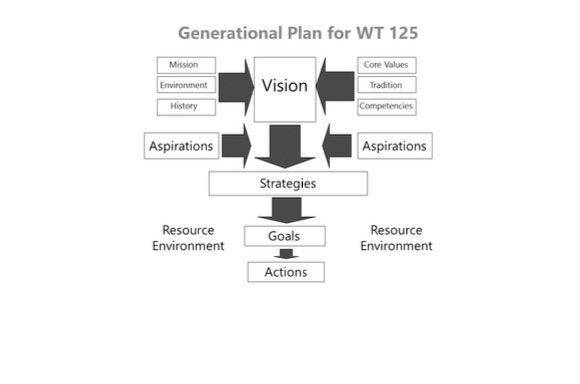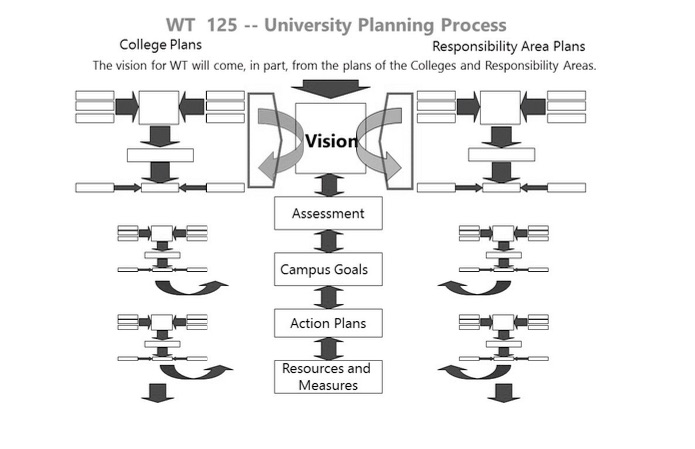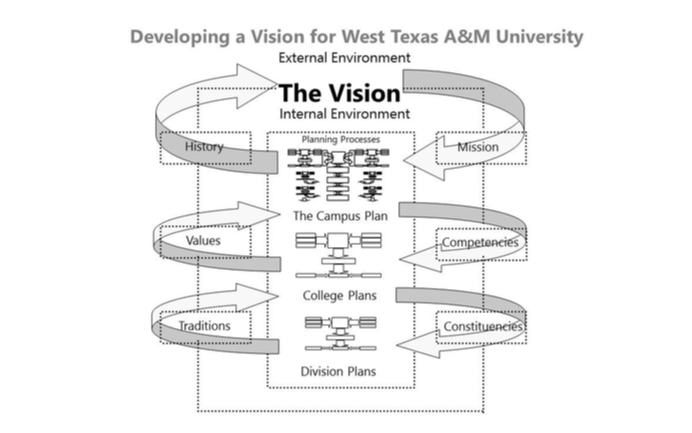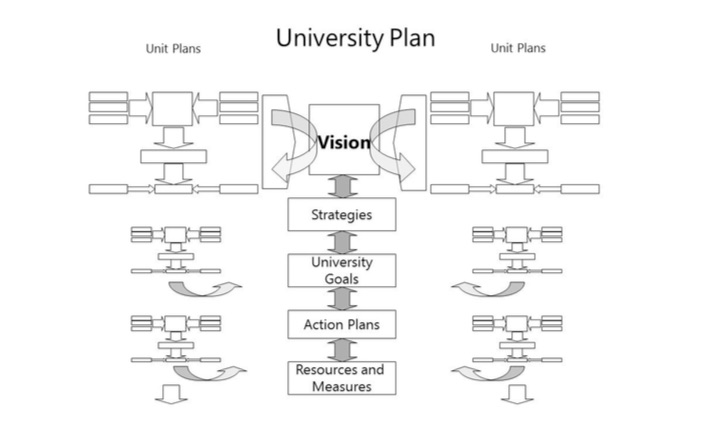Understanding WT 125
The purpose of WT 125 defines what WT should look like in the year 2035. What is the relationship of WT 125 to the University’s ongoing strategic planning processes? Different planning methodologies use identical terms in a variety of ways. This section describes WT 125, defines how terms are used in WT 125 and in future strategic planning at the University, and details how WT 125 relates to existing planning efforts. WT hopes this missive will serve to clarify any confusion about either issue.
The University’s WT 125 is best described as a generational strategic planning process. A generational plan is not a strategic plan. While a strategic plan attempts to define goals and set strategies to achieve them, the generational plan is more of a view to the future. WT uses the term generational strategic planning because the process is one that may not occur more than once in a generation. Like all strategic planning, it is aimed at looking in a deliberate and formal way at the institution’s internal and external environments in order to develop strategic directions that align with the environment and will ensure excellence and prosperity. What distinguishes it from ongoing planning processes is the length of the time frame being considered, the magnitude of the changes being considered, and the fact that it is engaging more stakeholders, especially external ones, than strategic planning usually does. Although major strategic planning initiatives are often set in motion by crisis or impending crisis, that is not the case with WT 125. WT has consistently improved its programs and its reputation over the past 25 years. It is in very good shape.
The generational planning process requires that current positions are understood, that history, traditions, corporate lore, and myth are incorporated, and that thinking about the future is built on four elements.
- Present Configuration – The University is understood through its present configuration, placement in relationship to other institutions, strengths, and weaknesses.
- History – The life of the University is understood relative to itself. What is it that defines WT? Where has it been?
- The Environment – The shapers of the University for which planning is being carried out, both external and internal. In a sense, this is a combination of the first two elements plus the environment or environments that effected it over its history. What might the environment look like in the future? What impact might that environment configuration have on the University?
- The Visions – The dreams of the University manifest through members or associates of it wrapped around the mission. While there will be a single mission unique to WT, there may be a number of visions that are consistent with that mission. These visions define the University for the future, and they are specific to the present configuration. In other words, the same generational planning process carried out five years from now would probably have a different set of visions, although the mission might not change. Given the first three elements, what are the dreams of and for the place? This is a corporate rather than individual question; although, those who work and study at WT and those who have worked and studied at WT drive it.

WT 125 assembles various stakeholders of the institution to answer the question, “How can WT become a doctoral university, focused on being a Regional Research University, and be recognized as such?” WT 125 participants are asked to further articulate what being among the best means for WT, given its particular history and environment. WT 125 participants are also asked to do the analysis and creative thinking that will provide specific big ideas or strategies and their associated goals and actions to achieve this vision. WT 125 considers these charges within the context of the important elements of WT’s environment; its core values, history, distinctive competencies, strengths and weaknesses; and its resources.
How WT 125 Fits with Ongoing WTAMU Planning
The following charts help clarify the various levels of planning at WT and how they relate to each other. At each level, the process is much the same and result in strategies, goals, and actions that are developed in light of the environment in which the area operates and the overarching vision of the University. At the unit levels, the heart of the University where educational opportunity is provided to students, the action plans lead to more specific resource requirements. It is clear that strategic planning is not conceived of as a strictly linear or hierarchical process. It is interactive at all levels with WT 125 setting the context and major strategic directions.

Unit Planning
The unit plans are critical to the overall planning process. The units are at the core of providing educational opportunity to students, and therefore understand the opportunities and costs associated with the overall movement of the University. For effective unit planning to occur, the unit is responsive to both University and generational planning processes. Frequently unit plans inform directions for the longer-term plans of the institution. For example, if quality is evidenced in certain programs, that in turn may help shape the University and generational plans as they are formulated. Unit plans are updated annually, and thoroughly reviewed on the four-year cycle, consistent with the University plan.
Of all the planning processes, the unit plans are most focused on defining strategies for the allocation of resources to achieve desired results. The inevitable growth and change that is required for WT are realized in the various units of the campus. Quality in the enterprise grows from unit plans that are both responsive to and informative for the University plan, and, likewise, the cycle continues to include generational planning efforts.
One outcome of WT 125 is the establishment of a University Planning and Assessment Committee, which keeps its finger on the pulse of the University as a whole.

University Planning
University planning is driven by the vision and goals set out in the generational plan. It is more specific, sets goals for a four-year window, and involves an internal set of stakeholders more than does the generational plan. Moreover, while the generational plan addresses resources in a global way, the university plan articulates paths of action to generate and allocate resources more specifically.
The university plan is responsive to the vision, goals, and actions set out in the generational plan, and simultaneously is responsive to the planning that occurs at the various unit levels on the campus. An interactive process involving the various planning units on campus fuels the immediate or short-term vision identified in the university plan. These units range from divisions, such as the Division of Student Enrollment, Engagement and Success, to colleges, such as the College of Business, out to academic and service departments. In order for the university planning process to be effective, it is responsive to the generational planning processes, and the unit planning processes simultaneously. This requires frequent communication regarding aspirations, resources, and priorities up and down the hierarchical structure of the institution.

Glossary
Strategic planning answers the question, “Where does the university want to go?” It is a formal process that clarifies the University’s vision of itself and helps set the strategic direction that will ensure its long-term stability and prosperity. It is both an analytical and a creative process. Strategic planning helps the organization develop a strategic direction by systematically and continuously considering the most important elements in its social, political, economic, technological, and other environments as well as its own distinctive competencies, strengths, and weaknesses. It is future-focused, but because it is impossible to forecast the future accurately, strategic planning is an ongoing process that helps the institution select short-term goals and actions that move it toward achieving its long-term vision.
Strategic planning takes place at every level of the University. Institution-wide, strategic planning sets the stage and gives the context for strategic planning at the college and department level. In the context of higher education, the University’s vision is initially articulated by the president and refined in college processes. Strategies result from the same formal collegial process that involves the institution’s leadership as well as its major stakeholders, including faculty, staff, students, and alumni. It must also be noted that strategies also emerge over time in an entrepreneurial way from individual units and only be recognized as a strategy once they are successful. Strategic planning is an ongoing process that constantly keeps the University in touch with its environment and how changes there affect its strategies, goals, and actions associated with achieving its long-term vision.
Generational strategic planning is much the same process, but occurs less frequently, involves more stakeholders, and looks further into the future. WT 125 is such a process.
The vision encapsulates the overarching direction and ideas that animate the organization and all its efforts. It is usually first articulated by the president and then refined in a collegial process. The institution’s mission, environment, history, core values, traditions, and distinctive competencies must be considered in its development.
Strategies are the agreed-upon major directions that align the institution with its environment and help it achieve its vision. Again, strategies are developed within the context of the institution’s environment, history, mission, distinctive competencies, and core values. In WT 125, the University use the term “big ideas” to differentiate these institution-wide strategies from those generated by colleges and departments. College and department strategies are aligned with institutional ones.
Goals derive from strategies and are more specific, measurable targets. When goals are accomplished, they lead to realization of one or more of the visions. If goals are accomplished but the institution is not close to realizing its vision, the strategies and goals need to be reconsidered. At the institutional level, accomplishment of a goal is likely to be the result of contributions from any number of units on campus. College and department goals should be aligned with the University’s strategic plan. Recommended actions are specific steps taken to accomplish goals. They provide the details of what will be done, who will do it, and what resources will be required. Actions are, by definition, operational.
Aspiration statements are requested from the theme groups in relation to their area. These statements inform the final institutional vision that emerges from the WT 125 process. They provide a sense of what the University is like and what the people of the University want it to look like in the future.
Core values are the collective beliefs and commitments that guide the thoughts and actions of the individuals in an organization. They play a major role in defining organizational culture. For example, a core value at WT is the commitment to the development of leaders.
Environment encompasses the demographic, social, cultural, political, technological, and economic environments in which the University operates. Current students, desired students, competitors, resource availability, technological considerations as well as constraints imposed by demographics and political realities are some of the environmental factors considered in developing a strategic plan.
Distinctive competencies are the programs and areas of the University which are universally recognized as being the best when compared with other similar programs and which are instrumental in the realization of the institution’s vision.
Mission in a university is usually defined or has its boundaries set by others, such as the state legislature and the Board of Regents. Strategic vision is developed within the boundaries of the University’s broadly defined mission.
A mission statement summarizes the institution’s defined mission, often in a somewhat generic way that does little to distinguish it from other similar institutions. While it verbalizes the boundaries of the mission and must be attended to, it is not of major help in strategic planning, but intended to position the University as a unique organization.
The history of WT informs both the present and future. Inattention to WT’s history might cause inherent cultural and organizational strengths to be overlooked. In addition, the trajectory set by understanding the past and coupling it to the present, allow a clearer view of possible futures to emerge. The identification of possible futures is the essence of planning.
Traditions are one important part of WT’s history. WT’s culture values traditions highly, and they are considered as efforts evolve to continue the development of high-quality academic offerings. Typically, traditions are thought of in WT’s environment as those activities centered on the student life experience that give character to the University. For the purposes of planning, history is a concept that encompasses a larger set of issues than traditions. For example, WT’s deep history includes strength in education programs. WT’s recent history includes strength in Agriculture, Business, Nursing, the Arts and Humanities, and increasingly, Engineering offerings. These are not thought of as traditions, but they are.
These are the basics of the WT planning effort at the University, the effort that is called WT 125.
